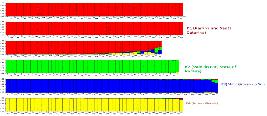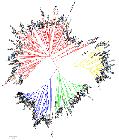Abstract
The objective of this work was to screen sweet cassava accessions collected in smallholding areas in the Midwestern, Southeastern and Southern regions of Brazil, using 15 SSR molecular markers, to determine population structure and genetic diversity. Polymorphism was detected in every loci analyzed, with mean of 6.33 alleles per locus, and mean polymorphism information content (PIC) of 0.6057, pointing out that the primers were highly informative. The observed heterozygosity ranged from 0.0709 (SSRY 101) to 0.9398 (GA 12), with a mean of 0.6511, and mean genetic diversity of 0.6578, ranging from 0.3592 (GA 136) to 0.8116 (SSRY 21). The most dissimilar combinations observed were BGM526PR-BGM596MS, BGM526PR-BGM622MS and BGM526PR-BGM629MS. The traditional cassava cultivars assessed were divided into four distinct groups: two with cultivars from the South, one from the Southeast and one from the Midwestern region of Brazil. The variances among and within groups determined by the analysis of molecular variance were 44 and 56%, respectively. The PhiPT parameter (analogue to Fst) of 0.44 indicates high differentiation among groups. Broad genetic diversity was found among the traditional sweet cassava cultivars assessed, and the most divergent groups were formed by cultivars from the South and the Midwestern regions of Brazil.
Keywords:
Manihot esculenta; germplasm characterization; genetic variability; SSR markers

 Thumbnail
Thumbnail
 Thumbnail
Thumbnail
 Thumbnail
Thumbnail
 Thumbnail
Thumbnail



